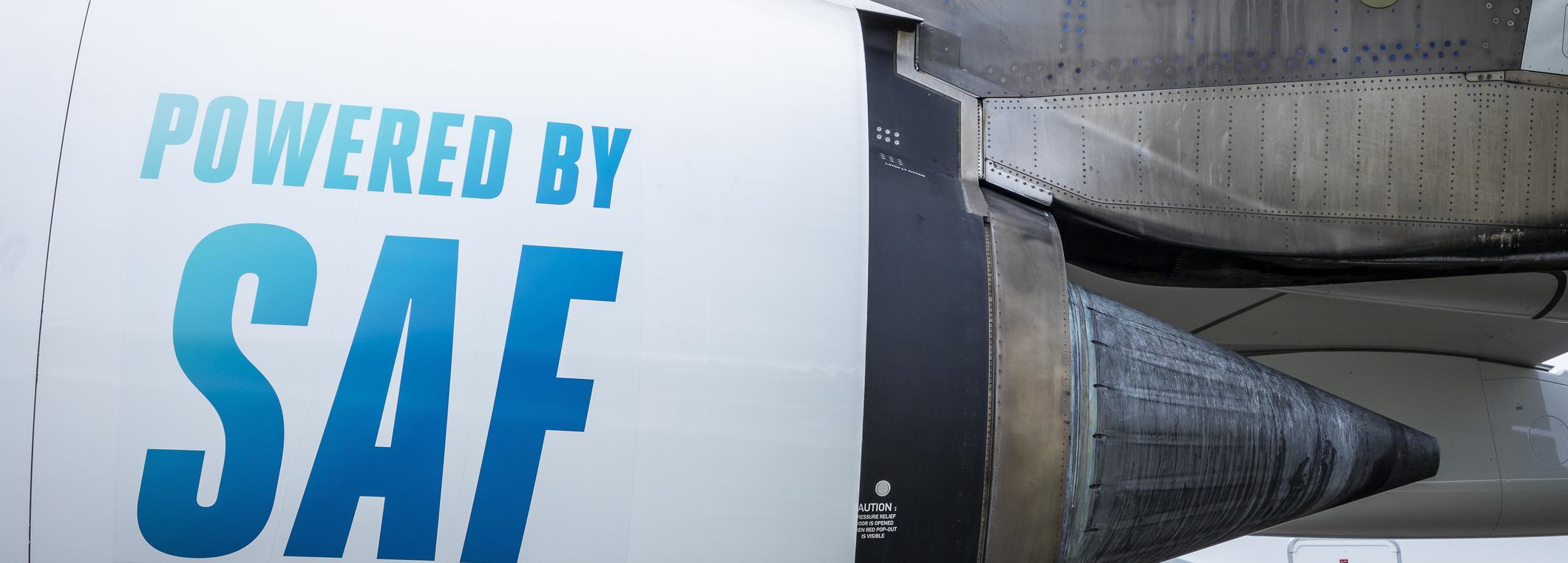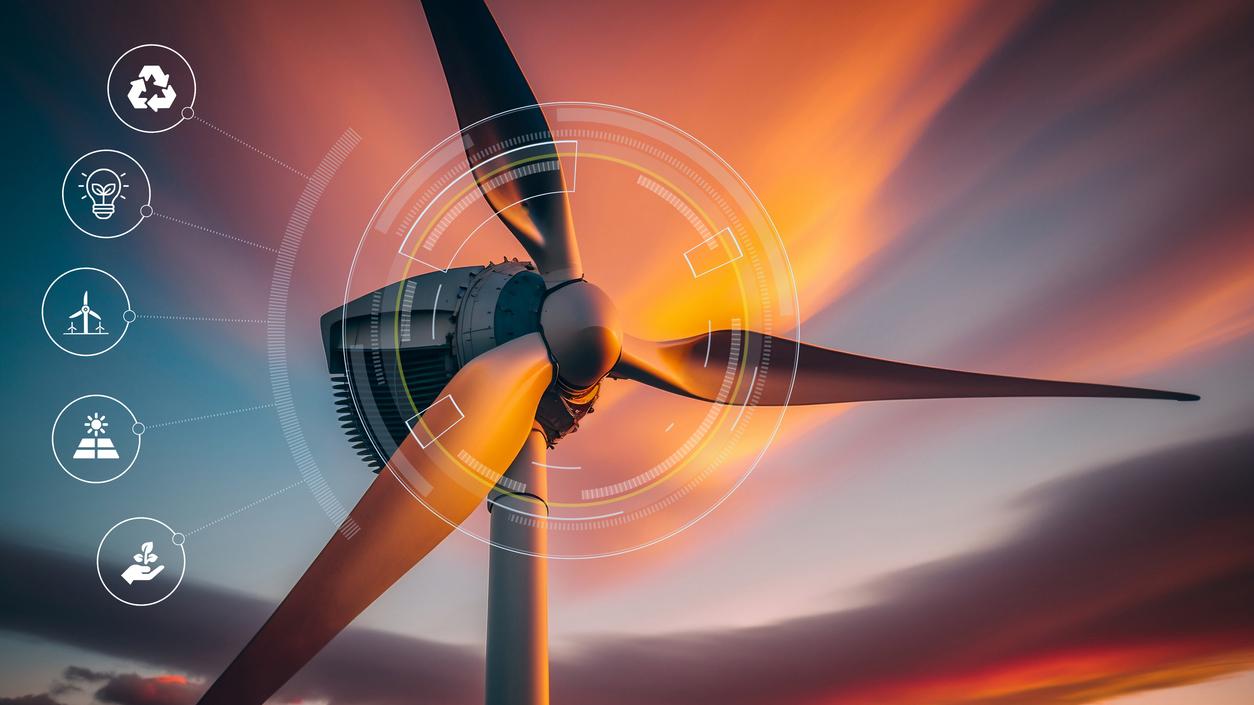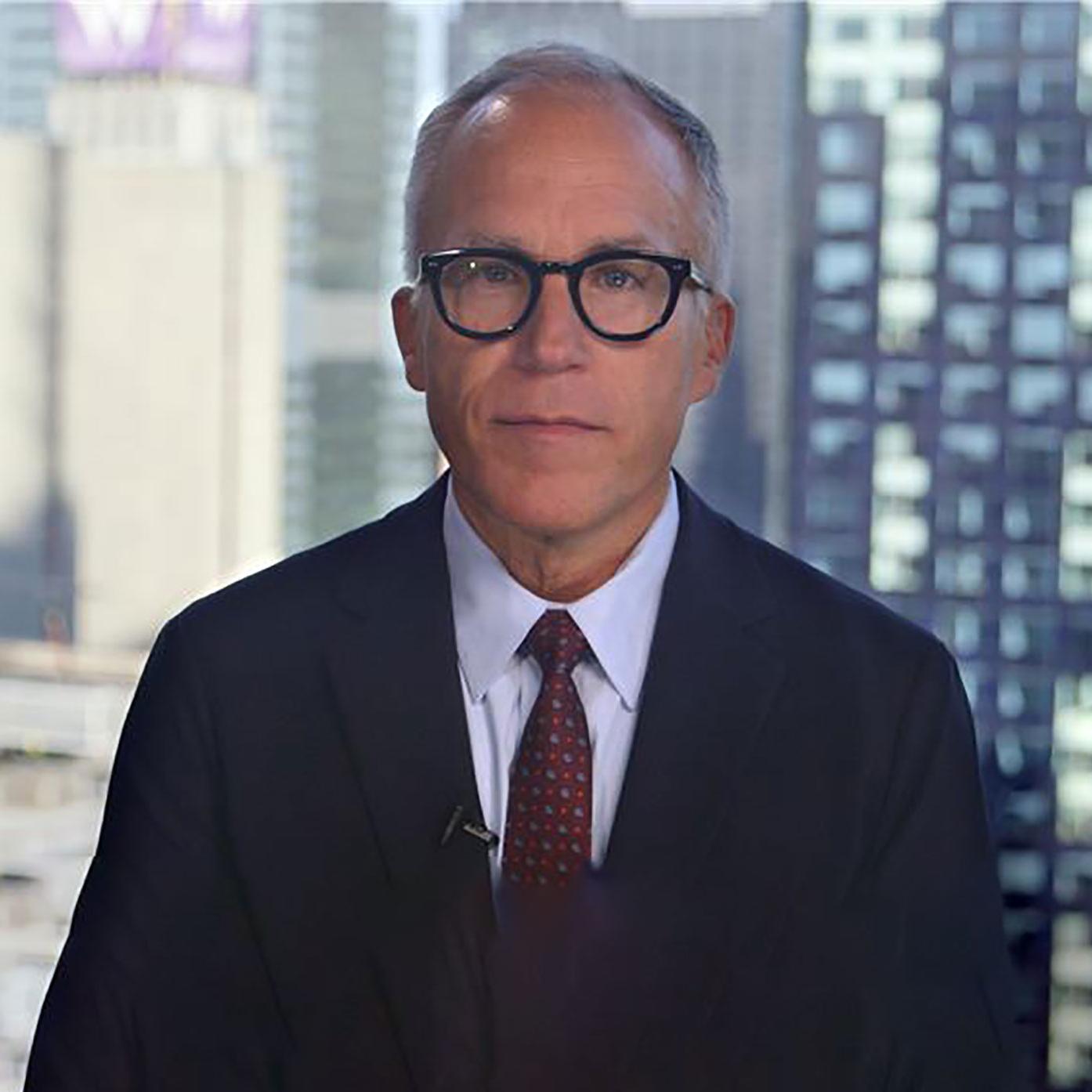
Breakthrough Energy: From Innovations to Investment
-
bookmark
-
print
Identifying the most promising innovations in clean energy and turning them into commercially viable solutions are not easy to do. In the newest episode of Sustainability Leaders, Michael Torrance, Chief Sustainability Officer with BMO, sits down with Tyson White, Director of Partnerships at world leading venture and catalyst investor Breakthrough Energy.
Founded by philanthropist and investor Bill Gates, Breakthrough Energy is a group of organizations that invests in clean energy innovations and climate solutions. The discussion covers promising innovations in the clean energy space, approaches to investment and how to lower the barriers to capital to foster more innovation.
Listen to the ~30-minute episode.
Tyson White:
What if we de-bottlenecked energy, and what if we were able to do it in a non-carbon-intensive way? And I think for a lot of our companies, that's really what this is about is finding better, cheaper, more efficient ways to decarbonize the economy. And those tailwinds, they're as robust as ever.
Michael Torrance:
Welcome to Sustainability Leaders. I'm Michael Torrance, chief sustainability officer at BMO. On this show, we will talk with leading sustainability practitioners from the corporate, investor, academic, and NGO communities to explore how this rapidly evolving field of sustainability is impacting global investment, business practices, and our world.
Disclosure:
The views expressed here are those of the participants and not those of Bank of Montreal, its affiliates, or subsidiaries.
Michael Torrance:
Identifying the most promising innovations in clean energy and turning them into commercially viable solutions is no easy task. Today's guest comes from an organization that is focused on that topic. Founded by Bill Gates in 2015, Breakthrough Energy is a group of organizations focused on innovation that can drive the transition to a net-zero world. BMO is a partner with Breakthrough Energy Catalyst, which accelerates development technologies critical to reducing emissions. My guest today is Tyson White, director of partnerships at Breakthrough Energy. Thanks for joining the podcast today, Tyson.
Tyson White:
Thank you for having me.
Michael Torrance:
So, Tyson, can you just start off by telling our audience about Breakthrough Energy? How is it organized, and how would you describe Breakthrough Energy's approach to investment?
Tyson White:
Happy to. So as you mentioned, we were stood up by Bill Gates around 2015, so we're approaching our 10-year anniversary. And I think part of the reason why we were established was largely because Bill felt that this concept of innovation was not front and center in terms of how we get to net-zero as a global economy. So he created this institution to try to accelerate that innovation to market. And when you fast-forward to today, now approaching our 10-year anniversary, what do we actually look like? We're organized across three core areas, discovery, development and deployment, all working to accelerate climate tech to market.
So what does that mean in practice? And I'll drill down first on that development, kind of that middle pillar. At our core, we are a venture capital fund, with approaching around 4 billion under management and somewhere in the neighborhood of 110, perhaps up to 120 portfolio companies now at this stage. About, I think it's 85 or 90% of the first investments that we make in these companies are between the seed and the A round, so very, very early into these companies. And we've been at it now investing out of those early stage funds for probably about seven or eight years. So we have, again, a pretty large cohort. And what that's caused is an expansion of the platform. Again, at our core or that VC platform, we now have an earlier-stage vehicle on the discovery angle, which is Breakthrough Energy Fellows. So it's supporting very early-stage innovations with non-dilutive funding into those companies, really before any kind of material capital has been raised.
And on the other side of the VC pillar, I would describe our deployment angle, which is the Breakthrough Energy Catalyst program. And rather than deploying capital into companies, Catalyst is investing in projects, so really focused on catalytic capital, project-level equity and grants, into first-of-a-kind climate technology projects.
We execute a partnerships function, which is where my role is currently sitting, and we work with corporations around the world, including financials, and help to understand their mandates. What are they solving for with their own energy needs or decarbonization objectives, and how can we understand what those are and meet those with the innovation that is being developed across our portfolio? Strategic communications as well, making sure that the world is aware of what is coming down the pipe. What are these next generation of innovations that might be relevant to their business, to their platform, or wherever they sit in the world, and also trying to become really a model that others can follow.
What I would also add, and one of the key pillars, is not just accelerating climate tech innovation to market, but we know that in order to do that we have to be focused on green premium reduction. That's one of the terms that Bill coined that's key to everything we do. And while we do have some philanthropic capital mixed with some more market return-seeking capital, we know that unless we can drive down the cost of these next-generation technologies closer to parity, or ideally they add over time a discount to the fossil incumbents, then they're going to struggle.
So a lot of these interventions, both the capital deployment platforms and the institution that surrounds it, is really focused not only on getting this innovation out into the market, but doing it in a way that can accelerate industrial adoption by driving down the cost and accelerate bankability.
Michael Torrance:
So stepping a bit back from that very pragmatic approach of focusing on the economics of these types of innovation, I understand breakthrough energy was created to address five so-called great challenges. Can you just describe what those are?
Tyson White:
Certainly. When you look at the way the economy is divided, there's certain sectors and areas, and how do you make sense of how the global economy is currently causing emissions? For us, and a lot of this ties back to Bill's book, we've divided them, as you mentioned, into the five grand challenge areas: manufacturing, electricity, food and agriculture, transportation, and buildings. And again, when you look at the breadth of what 100 or 120 portfolio companies mean across those, it's somewhat evenly divided. But we've done a deep-dive into each of those spaces and sort of understanding where there's technological need, what has a path to market versus what might be more niche, and trying to sub-identify the technologies that we think will be key, meeting the key tenants, the key challenges within each of those five grand challenge areas.
So sort of some examples of how that looks, if you look at the electrification space, for example, identifying a company like Fervo, geothermal technology platform using horizontal drilling and applying it in much more efficient ways. That's a company that has already announced their first sites, very well-capitalized at this stage. They have offtake commitments. That's an example of an innovative approach to power generation that is accelerating towards market. Also things like form energy, which have an iron-air battery concept, addressing the need of how we bridge renewables with the requirements of how a grid requires firm or baseload capacity.
And then if you look a little bit farther out on the spectrum, several fusion companies, and I would highlight Commonwealth Fusion Systems as being one that has certainly very well-capitalized, but will have some very interesting developments coming out over the next few years as they are currently building a first-of-a-kind commercial prototype machine that's about 40 miles actually west of where I'm standing right now. So you'll see not just an announcement that positive net energy was created, we've already had this out of the national labs, but it was done in a commercial model. And I think that's what really starts to bridge some of this innovation, this technology that we talked about to its application into a sector like electrification that certainly will be key.
We have several others. Boston Metal, I would highlight, in manufacturing. It's an electric arc furnace that can decarbonize steel. In the transportation space I would highlight one of the Catalyst projects we did around a power-to-liquid sustainable aviation fuel project that they're building in Texas. That'll be also first-of-a-kind with significant offtake commitments from the likes of American Airlines and Amazon that brought that whole thing together.
I'll just touch quickly on the buildings world as well because there we have a handful of companies where their technology can be bought today. I would point directly to LuxWall windows, super highly efficient windows. I think it's an R of 17, which is orders of magnitude better than existing windows, and you can just replace the pane; you don't have to replace the frame. So we've had a few of our corporate partners take a look at these windows and say, "You know what? The green premium is actually negative today. We can start thinking about installing these into some of our facilities today, and in fact save ourselves money even from the early stages of deploying them, and then certainly again over time due to the reduced energy consumption that they lead to."
There's a lot going on within each of these, so that's sort of how we make sense of it.
Michael Torrance:
So as you're deciding which innovations to invest in, what kind of characteristics are you looking for?
Tyson White:
I'll start with the company side, and the way our Breakthrough Energy Ventures team goes to market. So first of all, the initial investment into these companies, I think it's almost 90% of those initial investments are at the seed and A round stage, so very, very early with very, very deep technical diligence. The first hurdle that a technology and a company must overcome to be considered a candidate for investment is this concept of half a gigaton of greenhouse gas emission reduction per year by 2050. So every technology that we evaluate must make the case that by the year 2050, they can take out 1% of greenhouse gas emission reduction. So it's a pretty high hurdle.
Beyond that, we have, again, a very deep technical team, so does it work? Do we have a strong view that this technology itself will work, will be scalable, will be reliable, and ultimately will be sort of economically viable; it will, in fact, be a business rather than just an interesting tool or gadget or whatever it may be? And then does it have the ability to attract additional capital? Is this something that we can see over time will scale into the project or infrastructure finance marketplaces? So that's for our ventures arm.
I would just highlight briefly that the Breakthrough Energy Catalyst program, where we're investing in projects, has a slightly different mandate. That's much more focused on green premium reduction, meaning when that commercial facility is built, by how much is it going to reduce the green premium of that technology pathway? And does that, in fact, accelerate the path to market where that intervention or that financing of the first of a kind can lead to a second, a third, a fifth, a 10th, a 25th? So are we deploying our capital at a stage of development for that technology when we're taking the maximum bite out of green premium and we can sort of accelerate its pathway to market?
An example there would be if you could rewind to the '80s, in some of the back-testing we did when Catalyst was stood up, had you deployed a few billion into the PV solar market, could you have accelerated its path to market by accelerating its path down the cost curve by, again, deploying that capital into some of those earlier-stage deployments, but that had a little bit of a bigger green premium, at least for those initial deployments?
Michael Torrance:
What's the current state of the market for Breakthrough Energy investment and innovation? What are the areas that you're seeing that there is investment, that holds a lot of promise, or that are most in need of capital?
Tyson White:
So I think for us, we see a pretty strong sense of acceleration at this stage. And while there's certain undercurrents around the political environment and whose role various financing is and whose it's not, at the end of the day, we see the need for increased energy and the innovation that unlocks that as just a massive tailwind of these markets.
So I was in Davos as part of our delegation and listening to Satya at Microsoft talk about the interconnection of compute, connectivity, capital, and energy. And as he talks about that, we have abundance of compute, abundance of connectivity, and abundance of capital. Where the bottleneck really is is on the energy side. And I don't think that's something that was always appreciated in more developed markets where you've had efficiency gains and power demand and these economies hasn't grown materially for the past few decades. And now you're in this environment, and it's not just AI data centers. It's reshoring of manufacturing, it's electrification of everything that's driving this massive tailwind towards more energy consumption, largely electricity. And that's, I think, a really positive thing. It's something we can really embrace.
In terms of the harder-to-abate sectors, like heavy industry aviation and agriculture, there's just transformative solutions that are being required, and there's also some promising areas, I think, around carbon removal, certainly green hydrogen and sustainable fuels that are addressing those challenges, but at various stages. So I think there's some really good tailwinds.
Michael Torrance:
Well, there certainly seems to be an increasing need for energy across every aspect of our society, from computing data centers as being kind of the immediate example of that, and all kinds of energy are absolutely critical. You've already given us a lot of different really good examples, but can you provide any more examples to show how this type of investment and breakthrough technologies can be done successfully? There's obviously a huge degree of risk associated with this. How do you think about that, and how do you manage it?
Tyson White:
Yeah, so let me extract from the two other stages of our deployment platform, so the discovery, the really early stage, and there's an example of one of our companies that's starting to accelerate towards market. And then I'll touch on one, I think, out of the Catalyst program as well from a project perspective. So we invested, out of our fellows program, in a company called Molten Industries, and they produce graphite for batteries, as well as clean hydrogen for steel, so both. And it's using a methane pyrolysis process that generates no CO2 emissions, so just remarkable, remarkable science.
This is a company that we invested in at the very early stage out of our fellows program. Again, non-dilutive capital. These are grants to these companies, kept them doing the work, and this has now sort of accelerated to the point where our ventures arm has picked it up and has invested. It's now in sort of that development stage. It's really promising. I don't believe there's any graphite actually being produced within the United States right now due to some of the characteristics around manufacturing, but obviously something that's essential for the decarbonization. You look at your iPhone, and it exists in that. So just a fascinating technology that we were able to identify, meet the founders, work with them from a very early stage and you're really starting to see it kind of step up, not only through our platform, but towards the market. So that's one that I would highlight on a little bit of an earlier stage.
And then from the Catalyst perspective, one that I'm particularly excited about is the Infinium Roadrunner Project. So it's a power-to-liquid aviation fuel facility that is being built in Texas. They're converting carbon dioxide and renewable power into sustainable aviation fuel and some other low-carbon fuels, and it will reduce the life cycle emissions by up to 90%, so just dramatic, dramatic reduction and certainly, again, in a very-hard-to-decarbonize space. And what I love about this is it's an example of a technology that has progressed out of the lab into the stage where they're building a pretty significant commercial deployment. I think it's important not just because Catalyst came in and we've invested some money, but because it sort of bridged the chasm between being a venture-level investment, like sort of TopCo equity was where the majority of the capital was coming from, into a project, and that project was put into a structure that the massive pools of infrastructure finance recognized and became comfortable with.
So while Catalyst has invested in it and announced, I believe it's a $75 million project-level equity investment into the project, we saw an announcement from Brookfield coming in on top with over a billion dollars into the company, into the project, into a pipeline behind it. And I love this because, A, it's going to get built, and the characteristics of the project are incredible, but also what's happened is you are able to transition from a company that was really focused on this venture-capital-type equity that many of our companies start with and it's the pathway, and then transitioning into just a different environment of capital providers in terms of the infrastructure finance world, where the risk profiles are very different, but the size of capital is massive and I think we all know, for many of these companies, that type of capital will be required for that technology to scale and ultimately drive mass adoption of it. So that's one, to me, that I think really stands out as not just a good outcome, but a playbook and I think a model that we hope others will have the ability to follow.
Michael Torrance:
You're able to give some pretty interesting options to startups and companies in terms of financing. Looking more at the broader market, what are any barriers that you see in terms of access to capital to help foster this kind of innovation?
Tyson White:
For many of our companies, just having a really strong understanding of their own risk profile, like where it lies and the stage that their company is at, and as you're starting to graduate beyond TopCo equity investors and those later rounds, kind of transitioning to building things, making things. What you have to understand is you will never convince anyone that there's no risk in a first-of-a-kind project or manufacturing run or anything like that. It's much more about identifying and understanding the risks that are involved and ensuring that those risks are allocated to the parties that are mandated to take those types of risks.
So you kind of hear this concept of, "Okay, I'll raise this round and then that round, and then my project will be financed in the project or infrastructure marketplace," and while that may be true, there's a lot more to it than that. It's not as simple as someone rings a bell and all of a sudden you're ready for project and infra-finance. There's so many different layers of risk involved in those early projects, whether it's testing or permitting or all of the cost overrun issues, does it cost more to run even after it's built, really just having your arms around those and making sure that you've identified the right capital providers that can come in and are mandated to take those risks, making sure you're speaking to the right people.
I think for a lot of these companies that are transitioning to the point where they're building and deploying those first-of-a-kind elements of their path to market, we sort of started talking to them, at least I have, as the CLOUD risks. CapEx overrun may cost a lot more to build than you thought; L, late, what happens if it's just delayed by a year or two? Very challenging for financiers; O, OpEx overrun, meaning it just costs a lot more to actually operate; U, It underperforms, meaning you thought you had a 200-megawatt power facility, but when you turn it on it's only producing a hundred, and you ramp it up and it's 150. How do you actually meet the commercial commitments that you've made? And D is demand, meaning the offtake commitments or PPAs or whatever they may be, aren't written in a flexible way or the right way to ultimately allow the financiers to get comfortable that they can deploy capital to the project.
So I think really just having your arms around the risks associated with what it is that you're trying to build and then being able to have just an honest, upfront conversation with your off-takers, with the different financiers that are involved, and understanding how you can bridge some of those gaps, whether it's through the insurance marketplaces, whether it's through various government tools, et cetera.
Michael Torrance:
In terms of innovation and areas of focus, what are the top three technologies you're most interested in right now?
Tyson White:
So I think for me, there's always been a big fascination on the electrification side of the equation. I think a big part of the battle to decarbonize the economy is going to be the expansion of electrification. So for me, if I look at the near term, what we're seeing that I think is really exciting is some of the advancements coming out of geothermal. And again, I would point to Fervo with just some very strong momentum on the commercialization front. I also am seeing a lot of our long-duration energy storage companies. If you look out over the next one to two years, hopefully we'll see quite a few deployments, first-of-a-kind commercial or some scale-up deployments out of them. I think there's four or five of our companies that have different things in scope right now. So you'll really start to not only see those deployment, but have some early data behind them so we can start thinking about electrification and the grid itself and how these next-gen technologies are going to fit in because, again, we'll see them in the wild. We'll understand the data that's coming out of them.
I think if I look to today and where there's just maybe not quite as exciting as electrification, but you can buy them today and they have big impact, there's things like windows out of a company called LuxWall. Again, I think I mentioned it earlier, but an R of 17, it's a dramatic improvement. We've had a few financial institutions that have done some diligence on them and have committed to deploying them not because they're big global citizens, even though they are, but because they're cost-effective today.
Michael Torrance:
Tyson, what do you think the next five to ten years is going to look like in terms of the investment picture for this kind of energy innovation?
Tyson White:
Yeah, so for me, I just cannot wait to see what the world looks like when you have just the unlocked potential of things like fusion power. It's just going to be remarkable. I would also bundle probably SMRs into that as well. And you almost think about it as... I look at my cell phone. We all remember years ago we had friends and family plans, and there was this data metering, and you had to select when you were calling people; they were metering data. And now I think many of us probably have unlimited plans. It's become so cheap and ubiquitous that it's not even really worth metering. If you can dare to dream and start to imagine in the future, what does a world where power is so cheap that we don't have to meter it actually looks like?
And there's been some false starts, for sure. We had hoped that fission would be that reality at some point in the last century. Unfortunately, it didn't turn out that way, but some of these more cutting-edge technologies, and you think of what does a world with 10,000 arc reactors coming out of Commonwealth Fusion Systems look like, where there's abundant, clean, limitless electricity being generated, and what do we do with all that excess power? And it's pretty remarkable to take a step back and start thinking about what that, in fact, unlocks, not necessarily realizing in our daily lives, in the developed world, how big of a bottleneck electricity itself is in our own daily lives. So I think as you reach out over those, you start thinking a little bit farther into the future. That's sort of the dare-to-dream stuff. And there's certainly hurdles that need to be hit, but those are two technology pathways that I'm certainly watching very closely, I think many are, but just have tremendous, tremendous potential.
Michael Torrance:
I love the optimism, Tyson, and I also love how you're really thinking about this as a business-first challenge and how the economics are so important. And there's obviously a need for ideas and there's a need for people to take risk and to try to innovate. What advice would you have, based on what you've seen in the work you do, for inventors, innovators, entrepreneurs in this space in terms of advancing their ideas from a concept to an eventual product?
Tyson White:
And I think I'm going to focus on the last point that you made, advancing their ideas from a concept to a product. A lot of entrepreneurs and a lot of this technology that's being developed, you can have a concept and you can make one, but the best companies within our portfolio, they're actually building companies and enterprises that you go to visit them and it's so real. It doesn't feel like a startup any longer. They have proper departments; they're organized; they have missions and goals and values; they have strong relationships with the right people, like their buyers; they know how to use the capital market system.
So build companies. You have to have that view from day one. How are you actually going to unlock the potential of this technology that you're developing? And it's very, very complicated to do. It doesn't always come natural to some of the entrepreneurs that are also developing the technology. They very often have PhDs and are very deep on advanced science, and the concept of building a marketing department doesn't always come naturally. But when you have those synergies and you can sort of feel the gravitas of the organization, and not just the technology, it just becomes really, really powerful.
Michael Torrance:
Tyson, can you tell us a little bit more about the BMO partnership with Breakthrough Energy?
Tyson White:
Absolutely. So when we were identifying the gap in the marketplace that we felt required to be filled, and this is, again, for the Catalyst program to start, we knew that there were a subset of financials out there that had not only thought about this themselves, but that there was an opportunity for collaboration. So when we were ultimately structuring and raising the Breakthrough Energy Catalyst program, we spent actually quite a bit of time with several colleagues at BMO, particularly Jonathan Hackett, where we were collaborating, how do you create an intervention that can help support and ultimately capitalize the pathway of these next-gen climate technologies, energy technology companies, to market? What was that funding vehicle that needed to be created? And ultimately, we stood up Catalyst, and the beginning of the partnership between Breakthrough Energy and BMO was largely around that Breakthrough Energy Catalyst program, where BMO is an investor. We've now funded, I believe it's eight or so projects.
But the collaboration between Breakthrough Energy and BMO has certainly extended much further. We seek opportunities to support each other, certainly when there's BMO clients that have technology gaps and needs in the marketplace, making sure that our companies are connected there. When our companies have financing needs that are in scope for some of the financing tools that BMO has available, we certainly reach out and try to make introductions and connections. But overall, we found an institution that is certainly committed to similar values and outcomes with our organization, and the collaboration that started with Catalyst has certainly expanded much more broadly between our two institutions. So we're very grateful for that partnership with BMO.
Michael Torrance:
We're just about at time, Tyson. Do you have any final thoughts that you'd like to share before we wrap up?
Tyson White:
For us, and you touched on it just a minute ago, the sense of optimism, and I hope that comes through because it's been, I think, bumpy for many entrepreneurs in climate tech as they look out into the market and say, "Is there an appetite for this? Is the world changing? Are we reverting back to fossil fuel intensity?" And I think for us, there's really never been a better time to do this. I would just continue to focus on the energy growth that is occurring within the global economy and the need for innovation and these next-gen technologies to step up and meet that.
So, again, I think the sense of optimism that we have in-house, not just that these companies will develop and they'll meet different demands, but that there truly continues to be tailwinds within the marketplace that continue to lead us to believe that this is just an absolutely outstanding investment class to be a part of, it will change form, it will change shape, we can't be tone-deaf to certain challenges, but humankind's just absolute hunger for incremental energy to power the way we live, the way the rest of the world is developing, is just a massive, massive tailwind that we continue to be tremendously excited about for what it means for innovation into the marketplace.
Michael Torrance:
Thanks very much for your time today, Tyson.
Tyson White:
Thank you.
Michael Torrance:
Thanks for listening to Sustainability Leaders. This podcast is presented by BMO. You can find our show on Apple Podcasts, Spotify, or your favorite podcast player. Press the Follow button if you want to get notified when new episodes are published. We value your input, so please leave a rating review and any feedback that you might have or visit us at bmo.com/sustainabilityleaders. Our show and resources are produced with support from BMO's marketing team and Puddle Creative. Until next time, thanks for listening, and have a great week.
Disclosure:
For BMO disclosures, please visit bmocm.com/podcast/disclaimer.

Breakthrough Energy: From Innovations to Investment
Chief Sustainability Officer
Michael Torrance is Chief Sustainability Officer of BMO Financial Group and is passionate about sustainability, especially as it pertains to corporate governance an…
Michael Torrance is Chief Sustainability Officer of BMO Financial Group and is passionate about sustainability, especially as it pertains to corporate governance an…
VIEW FULL PROFILE-
Minute Read
-
Listen
Stop
-
Text Bigger | Text Smaller
Identifying the most promising innovations in clean energy and turning them into commercially viable solutions are not easy to do. In the newest episode of Sustainability Leaders, Michael Torrance, Chief Sustainability Officer with BMO, sits down with Tyson White, Director of Partnerships at world leading venture and catalyst investor Breakthrough Energy.
Founded by philanthropist and investor Bill Gates, Breakthrough Energy is a group of organizations that invests in clean energy innovations and climate solutions. The discussion covers promising innovations in the clean energy space, approaches to investment and how to lower the barriers to capital to foster more innovation.
Listen to the ~30-minute episode.
Tyson White:
What if we de-bottlenecked energy, and what if we were able to do it in a non-carbon-intensive way? And I think for a lot of our companies, that's really what this is about is finding better, cheaper, more efficient ways to decarbonize the economy. And those tailwinds, they're as robust as ever.
Michael Torrance:
Welcome to Sustainability Leaders. I'm Michael Torrance, chief sustainability officer at BMO. On this show, we will talk with leading sustainability practitioners from the corporate, investor, academic, and NGO communities to explore how this rapidly evolving field of sustainability is impacting global investment, business practices, and our world.
Disclosure:
The views expressed here are those of the participants and not those of Bank of Montreal, its affiliates, or subsidiaries.
Michael Torrance:
Identifying the most promising innovations in clean energy and turning them into commercially viable solutions is no easy task. Today's guest comes from an organization that is focused on that topic. Founded by Bill Gates in 2015, Breakthrough Energy is a group of organizations focused on innovation that can drive the transition to a net-zero world. BMO is a partner with Breakthrough Energy Catalyst, which accelerates development technologies critical to reducing emissions. My guest today is Tyson White, director of partnerships at Breakthrough Energy. Thanks for joining the podcast today, Tyson.
Tyson White:
Thank you for having me.
Michael Torrance:
So, Tyson, can you just start off by telling our audience about Breakthrough Energy? How is it organized, and how would you describe Breakthrough Energy's approach to investment?
Tyson White:
Happy to. So as you mentioned, we were stood up by Bill Gates around 2015, so we're approaching our 10-year anniversary. And I think part of the reason why we were established was largely because Bill felt that this concept of innovation was not front and center in terms of how we get to net-zero as a global economy. So he created this institution to try to accelerate that innovation to market. And when you fast-forward to today, now approaching our 10-year anniversary, what do we actually look like? We're organized across three core areas, discovery, development and deployment, all working to accelerate climate tech to market.
So what does that mean in practice? And I'll drill down first on that development, kind of that middle pillar. At our core, we are a venture capital fund, with approaching around 4 billion under management and somewhere in the neighborhood of 110, perhaps up to 120 portfolio companies now at this stage. About, I think it's 85 or 90% of the first investments that we make in these companies are between the seed and the A round, so very, very early into these companies. And we've been at it now investing out of those early stage funds for probably about seven or eight years. So we have, again, a pretty large cohort. And what that's caused is an expansion of the platform. Again, at our core or that VC platform, we now have an earlier-stage vehicle on the discovery angle, which is Breakthrough Energy Fellows. So it's supporting very early-stage innovations with non-dilutive funding into those companies, really before any kind of material capital has been raised.
And on the other side of the VC pillar, I would describe our deployment angle, which is the Breakthrough Energy Catalyst program. And rather than deploying capital into companies, Catalyst is investing in projects, so really focused on catalytic capital, project-level equity and grants, into first-of-a-kind climate technology projects.
We execute a partnerships function, which is where my role is currently sitting, and we work with corporations around the world, including financials, and help to understand their mandates. What are they solving for with their own energy needs or decarbonization objectives, and how can we understand what those are and meet those with the innovation that is being developed across our portfolio? Strategic communications as well, making sure that the world is aware of what is coming down the pipe. What are these next generation of innovations that might be relevant to their business, to their platform, or wherever they sit in the world, and also trying to become really a model that others can follow.
What I would also add, and one of the key pillars, is not just accelerating climate tech innovation to market, but we know that in order to do that we have to be focused on green premium reduction. That's one of the terms that Bill coined that's key to everything we do. And while we do have some philanthropic capital mixed with some more market return-seeking capital, we know that unless we can drive down the cost of these next-generation technologies closer to parity, or ideally they add over time a discount to the fossil incumbents, then they're going to struggle.
So a lot of these interventions, both the capital deployment platforms and the institution that surrounds it, is really focused not only on getting this innovation out into the market, but doing it in a way that can accelerate industrial adoption by driving down the cost and accelerate bankability.
Michael Torrance:
So stepping a bit back from that very pragmatic approach of focusing on the economics of these types of innovation, I understand breakthrough energy was created to address five so-called great challenges. Can you just describe what those are?
Tyson White:
Certainly. When you look at the way the economy is divided, there's certain sectors and areas, and how do you make sense of how the global economy is currently causing emissions? For us, and a lot of this ties back to Bill's book, we've divided them, as you mentioned, into the five grand challenge areas: manufacturing, electricity, food and agriculture, transportation, and buildings. And again, when you look at the breadth of what 100 or 120 portfolio companies mean across those, it's somewhat evenly divided. But we've done a deep-dive into each of those spaces and sort of understanding where there's technological need, what has a path to market versus what might be more niche, and trying to sub-identify the technologies that we think will be key, meeting the key tenants, the key challenges within each of those five grand challenge areas.
So sort of some examples of how that looks, if you look at the electrification space, for example, identifying a company like Fervo, geothermal technology platform using horizontal drilling and applying it in much more efficient ways. That's a company that has already announced their first sites, very well-capitalized at this stage. They have offtake commitments. That's an example of an innovative approach to power generation that is accelerating towards market. Also things like form energy, which have an iron-air battery concept, addressing the need of how we bridge renewables with the requirements of how a grid requires firm or baseload capacity.
And then if you look a little bit farther out on the spectrum, several fusion companies, and I would highlight Commonwealth Fusion Systems as being one that has certainly very well-capitalized, but will have some very interesting developments coming out over the next few years as they are currently building a first-of-a-kind commercial prototype machine that's about 40 miles actually west of where I'm standing right now. So you'll see not just an announcement that positive net energy was created, we've already had this out of the national labs, but it was done in a commercial model. And I think that's what really starts to bridge some of this innovation, this technology that we talked about to its application into a sector like electrification that certainly will be key.
We have several others. Boston Metal, I would highlight, in manufacturing. It's an electric arc furnace that can decarbonize steel. In the transportation space I would highlight one of the Catalyst projects we did around a power-to-liquid sustainable aviation fuel project that they're building in Texas. That'll be also first-of-a-kind with significant offtake commitments from the likes of American Airlines and Amazon that brought that whole thing together.
I'll just touch quickly on the buildings world as well because there we have a handful of companies where their technology can be bought today. I would point directly to LuxWall windows, super highly efficient windows. I think it's an R of 17, which is orders of magnitude better than existing windows, and you can just replace the pane; you don't have to replace the frame. So we've had a few of our corporate partners take a look at these windows and say, "You know what? The green premium is actually negative today. We can start thinking about installing these into some of our facilities today, and in fact save ourselves money even from the early stages of deploying them, and then certainly again over time due to the reduced energy consumption that they lead to."
There's a lot going on within each of these, so that's sort of how we make sense of it.
Michael Torrance:
So as you're deciding which innovations to invest in, what kind of characteristics are you looking for?
Tyson White:
I'll start with the company side, and the way our Breakthrough Energy Ventures team goes to market. So first of all, the initial investment into these companies, I think it's almost 90% of those initial investments are at the seed and A round stage, so very, very early with very, very deep technical diligence. The first hurdle that a technology and a company must overcome to be considered a candidate for investment is this concept of half a gigaton of greenhouse gas emission reduction per year by 2050. So every technology that we evaluate must make the case that by the year 2050, they can take out 1% of greenhouse gas emission reduction. So it's a pretty high hurdle.
Beyond that, we have, again, a very deep technical team, so does it work? Do we have a strong view that this technology itself will work, will be scalable, will be reliable, and ultimately will be sort of economically viable; it will, in fact, be a business rather than just an interesting tool or gadget or whatever it may be? And then does it have the ability to attract additional capital? Is this something that we can see over time will scale into the project or infrastructure finance marketplaces? So that's for our ventures arm.
I would just highlight briefly that the Breakthrough Energy Catalyst program, where we're investing in projects, has a slightly different mandate. That's much more focused on green premium reduction, meaning when that commercial facility is built, by how much is it going to reduce the green premium of that technology pathway? And does that, in fact, accelerate the path to market where that intervention or that financing of the first of a kind can lead to a second, a third, a fifth, a 10th, a 25th? So are we deploying our capital at a stage of development for that technology when we're taking the maximum bite out of green premium and we can sort of accelerate its pathway to market?
An example there would be if you could rewind to the '80s, in some of the back-testing we did when Catalyst was stood up, had you deployed a few billion into the PV solar market, could you have accelerated its path to market by accelerating its path down the cost curve by, again, deploying that capital into some of those earlier-stage deployments, but that had a little bit of a bigger green premium, at least for those initial deployments?
Michael Torrance:
What's the current state of the market for Breakthrough Energy investment and innovation? What are the areas that you're seeing that there is investment, that holds a lot of promise, or that are most in need of capital?
Tyson White:
So I think for us, we see a pretty strong sense of acceleration at this stage. And while there's certain undercurrents around the political environment and whose role various financing is and whose it's not, at the end of the day, we see the need for increased energy and the innovation that unlocks that as just a massive tailwind of these markets.
So I was in Davos as part of our delegation and listening to Satya at Microsoft talk about the interconnection of compute, connectivity, capital, and energy. And as he talks about that, we have abundance of compute, abundance of connectivity, and abundance of capital. Where the bottleneck really is is on the energy side. And I don't think that's something that was always appreciated in more developed markets where you've had efficiency gains and power demand and these economies hasn't grown materially for the past few decades. And now you're in this environment, and it's not just AI data centers. It's reshoring of manufacturing, it's electrification of everything that's driving this massive tailwind towards more energy consumption, largely electricity. And that's, I think, a really positive thing. It's something we can really embrace.
In terms of the harder-to-abate sectors, like heavy industry aviation and agriculture, there's just transformative solutions that are being required, and there's also some promising areas, I think, around carbon removal, certainly green hydrogen and sustainable fuels that are addressing those challenges, but at various stages. So I think there's some really good tailwinds.
Michael Torrance:
Well, there certainly seems to be an increasing need for energy across every aspect of our society, from computing data centers as being kind of the immediate example of that, and all kinds of energy are absolutely critical. You've already given us a lot of different really good examples, but can you provide any more examples to show how this type of investment and breakthrough technologies can be done successfully? There's obviously a huge degree of risk associated with this. How do you think about that, and how do you manage it?
Tyson White:
Yeah, so let me extract from the two other stages of our deployment platform, so the discovery, the really early stage, and there's an example of one of our companies that's starting to accelerate towards market. And then I'll touch on one, I think, out of the Catalyst program as well from a project perspective. So we invested, out of our fellows program, in a company called Molten Industries, and they produce graphite for batteries, as well as clean hydrogen for steel, so both. And it's using a methane pyrolysis process that generates no CO2 emissions, so just remarkable, remarkable science.
This is a company that we invested in at the very early stage out of our fellows program. Again, non-dilutive capital. These are grants to these companies, kept them doing the work, and this has now sort of accelerated to the point where our ventures arm has picked it up and has invested. It's now in sort of that development stage. It's really promising. I don't believe there's any graphite actually being produced within the United States right now due to some of the characteristics around manufacturing, but obviously something that's essential for the decarbonization. You look at your iPhone, and it exists in that. So just a fascinating technology that we were able to identify, meet the founders, work with them from a very early stage and you're really starting to see it kind of step up, not only through our platform, but towards the market. So that's one that I would highlight on a little bit of an earlier stage.
And then from the Catalyst perspective, one that I'm particularly excited about is the Infinium Roadrunner Project. So it's a power-to-liquid aviation fuel facility that is being built in Texas. They're converting carbon dioxide and renewable power into sustainable aviation fuel and some other low-carbon fuels, and it will reduce the life cycle emissions by up to 90%, so just dramatic, dramatic reduction and certainly, again, in a very-hard-to-decarbonize space. And what I love about this is it's an example of a technology that has progressed out of the lab into the stage where they're building a pretty significant commercial deployment. I think it's important not just because Catalyst came in and we've invested some money, but because it sort of bridged the chasm between being a venture-level investment, like sort of TopCo equity was where the majority of the capital was coming from, into a project, and that project was put into a structure that the massive pools of infrastructure finance recognized and became comfortable with.
So while Catalyst has invested in it and announced, I believe it's a $75 million project-level equity investment into the project, we saw an announcement from Brookfield coming in on top with over a billion dollars into the company, into the project, into a pipeline behind it. And I love this because, A, it's going to get built, and the characteristics of the project are incredible, but also what's happened is you are able to transition from a company that was really focused on this venture-capital-type equity that many of our companies start with and it's the pathway, and then transitioning into just a different environment of capital providers in terms of the infrastructure finance world, where the risk profiles are very different, but the size of capital is massive and I think we all know, for many of these companies, that type of capital will be required for that technology to scale and ultimately drive mass adoption of it. So that's one, to me, that I think really stands out as not just a good outcome, but a playbook and I think a model that we hope others will have the ability to follow.
Michael Torrance:
You're able to give some pretty interesting options to startups and companies in terms of financing. Looking more at the broader market, what are any barriers that you see in terms of access to capital to help foster this kind of innovation?
Tyson White:
For many of our companies, just having a really strong understanding of their own risk profile, like where it lies and the stage that their company is at, and as you're starting to graduate beyond TopCo equity investors and those later rounds, kind of transitioning to building things, making things. What you have to understand is you will never convince anyone that there's no risk in a first-of-a-kind project or manufacturing run or anything like that. It's much more about identifying and understanding the risks that are involved and ensuring that those risks are allocated to the parties that are mandated to take those types of risks.
So you kind of hear this concept of, "Okay, I'll raise this round and then that round, and then my project will be financed in the project or infrastructure marketplace," and while that may be true, there's a lot more to it than that. It's not as simple as someone rings a bell and all of a sudden you're ready for project and infra-finance. There's so many different layers of risk involved in those early projects, whether it's testing or permitting or all of the cost overrun issues, does it cost more to run even after it's built, really just having your arms around those and making sure that you've identified the right capital providers that can come in and are mandated to take those risks, making sure you're speaking to the right people.
I think for a lot of these companies that are transitioning to the point where they're building and deploying those first-of-a-kind elements of their path to market, we sort of started talking to them, at least I have, as the CLOUD risks. CapEx overrun may cost a lot more to build than you thought; L, late, what happens if it's just delayed by a year or two? Very challenging for financiers; O, OpEx overrun, meaning it just costs a lot more to actually operate; U, It underperforms, meaning you thought you had a 200-megawatt power facility, but when you turn it on it's only producing a hundred, and you ramp it up and it's 150. How do you actually meet the commercial commitments that you've made? And D is demand, meaning the offtake commitments or PPAs or whatever they may be, aren't written in a flexible way or the right way to ultimately allow the financiers to get comfortable that they can deploy capital to the project.
So I think really just having your arms around the risks associated with what it is that you're trying to build and then being able to have just an honest, upfront conversation with your off-takers, with the different financiers that are involved, and understanding how you can bridge some of those gaps, whether it's through the insurance marketplaces, whether it's through various government tools, et cetera.
Michael Torrance:
In terms of innovation and areas of focus, what are the top three technologies you're most interested in right now?
Tyson White:
So I think for me, there's always been a big fascination on the electrification side of the equation. I think a big part of the battle to decarbonize the economy is going to be the expansion of electrification. So for me, if I look at the near term, what we're seeing that I think is really exciting is some of the advancements coming out of geothermal. And again, I would point to Fervo with just some very strong momentum on the commercialization front. I also am seeing a lot of our long-duration energy storage companies. If you look out over the next one to two years, hopefully we'll see quite a few deployments, first-of-a-kind commercial or some scale-up deployments out of them. I think there's four or five of our companies that have different things in scope right now. So you'll really start to not only see those deployment, but have some early data behind them so we can start thinking about electrification and the grid itself and how these next-gen technologies are going to fit in because, again, we'll see them in the wild. We'll understand the data that's coming out of them.
I think if I look to today and where there's just maybe not quite as exciting as electrification, but you can buy them today and they have big impact, there's things like windows out of a company called LuxWall. Again, I think I mentioned it earlier, but an R of 17, it's a dramatic improvement. We've had a few financial institutions that have done some diligence on them and have committed to deploying them not because they're big global citizens, even though they are, but because they're cost-effective today.
Michael Torrance:
Tyson, what do you think the next five to ten years is going to look like in terms of the investment picture for this kind of energy innovation?
Tyson White:
Yeah, so for me, I just cannot wait to see what the world looks like when you have just the unlocked potential of things like fusion power. It's just going to be remarkable. I would also bundle probably SMRs into that as well. And you almost think about it as... I look at my cell phone. We all remember years ago we had friends and family plans, and there was this data metering, and you had to select when you were calling people; they were metering data. And now I think many of us probably have unlimited plans. It's become so cheap and ubiquitous that it's not even really worth metering. If you can dare to dream and start to imagine in the future, what does a world where power is so cheap that we don't have to meter it actually looks like?
And there's been some false starts, for sure. We had hoped that fission would be that reality at some point in the last century. Unfortunately, it didn't turn out that way, but some of these more cutting-edge technologies, and you think of what does a world with 10,000 arc reactors coming out of Commonwealth Fusion Systems look like, where there's abundant, clean, limitless electricity being generated, and what do we do with all that excess power? And it's pretty remarkable to take a step back and start thinking about what that, in fact, unlocks, not necessarily realizing in our daily lives, in the developed world, how big of a bottleneck electricity itself is in our own daily lives. So I think as you reach out over those, you start thinking a little bit farther into the future. That's sort of the dare-to-dream stuff. And there's certainly hurdles that need to be hit, but those are two technology pathways that I'm certainly watching very closely, I think many are, but just have tremendous, tremendous potential.
Michael Torrance:
I love the optimism, Tyson, and I also love how you're really thinking about this as a business-first challenge and how the economics are so important. And there's obviously a need for ideas and there's a need for people to take risk and to try to innovate. What advice would you have, based on what you've seen in the work you do, for inventors, innovators, entrepreneurs in this space in terms of advancing their ideas from a concept to an eventual product?
Tyson White:
And I think I'm going to focus on the last point that you made, advancing their ideas from a concept to a product. A lot of entrepreneurs and a lot of this technology that's being developed, you can have a concept and you can make one, but the best companies within our portfolio, they're actually building companies and enterprises that you go to visit them and it's so real. It doesn't feel like a startup any longer. They have proper departments; they're organized; they have missions and goals and values; they have strong relationships with the right people, like their buyers; they know how to use the capital market system.
So build companies. You have to have that view from day one. How are you actually going to unlock the potential of this technology that you're developing? And it's very, very complicated to do. It doesn't always come natural to some of the entrepreneurs that are also developing the technology. They very often have PhDs and are very deep on advanced science, and the concept of building a marketing department doesn't always come naturally. But when you have those synergies and you can sort of feel the gravitas of the organization, and not just the technology, it just becomes really, really powerful.
Michael Torrance:
Tyson, can you tell us a little bit more about the BMO partnership with Breakthrough Energy?
Tyson White:
Absolutely. So when we were identifying the gap in the marketplace that we felt required to be filled, and this is, again, for the Catalyst program to start, we knew that there were a subset of financials out there that had not only thought about this themselves, but that there was an opportunity for collaboration. So when we were ultimately structuring and raising the Breakthrough Energy Catalyst program, we spent actually quite a bit of time with several colleagues at BMO, particularly Jonathan Hackett, where we were collaborating, how do you create an intervention that can help support and ultimately capitalize the pathway of these next-gen climate technologies, energy technology companies, to market? What was that funding vehicle that needed to be created? And ultimately, we stood up Catalyst, and the beginning of the partnership between Breakthrough Energy and BMO was largely around that Breakthrough Energy Catalyst program, where BMO is an investor. We've now funded, I believe it's eight or so projects.
But the collaboration between Breakthrough Energy and BMO has certainly extended much further. We seek opportunities to support each other, certainly when there's BMO clients that have technology gaps and needs in the marketplace, making sure that our companies are connected there. When our companies have financing needs that are in scope for some of the financing tools that BMO has available, we certainly reach out and try to make introductions and connections. But overall, we found an institution that is certainly committed to similar values and outcomes with our organization, and the collaboration that started with Catalyst has certainly expanded much more broadly between our two institutions. So we're very grateful for that partnership with BMO.
Michael Torrance:
We're just about at time, Tyson. Do you have any final thoughts that you'd like to share before we wrap up?
Tyson White:
For us, and you touched on it just a minute ago, the sense of optimism, and I hope that comes through because it's been, I think, bumpy for many entrepreneurs in climate tech as they look out into the market and say, "Is there an appetite for this? Is the world changing? Are we reverting back to fossil fuel intensity?" And I think for us, there's really never been a better time to do this. I would just continue to focus on the energy growth that is occurring within the global economy and the need for innovation and these next-gen technologies to step up and meet that.
So, again, I think the sense of optimism that we have in-house, not just that these companies will develop and they'll meet different demands, but that there truly continues to be tailwinds within the marketplace that continue to lead us to believe that this is just an absolutely outstanding investment class to be a part of, it will change form, it will change shape, we can't be tone-deaf to certain challenges, but humankind's just absolute hunger for incremental energy to power the way we live, the way the rest of the world is developing, is just a massive, massive tailwind that we continue to be tremendously excited about for what it means for innovation into the marketplace.
Michael Torrance:
Thanks very much for your time today, Tyson.
Tyson White:
Thank you.
Michael Torrance:
Thanks for listening to Sustainability Leaders. This podcast is presented by BMO. You can find our show on Apple Podcasts, Spotify, or your favorite podcast player. Press the Follow button if you want to get notified when new episodes are published. We value your input, so please leave a rating review and any feedback that you might have or visit us at bmo.com/sustainabilityleaders. Our show and resources are produced with support from BMO's marketing team and Puddle Creative. Until next time, thanks for listening, and have a great week.
Disclosure:
For BMO disclosures, please visit bmocm.com/podcast/disclaimer.
You might also be interested in
More U.S. and Canadian Companies Are Being Driven to Climate Action Because of Customer Expectations: Survey Shows

Financing Critical Minerals: Opportunities to Build New Investment Frameworks

Validating Breakthrough Energy Concepts, a Discussion with George Hathaway

How Developers and Builders Are Paving the Way for a Greener Future

From Farm to Future: How Funding Solutions are Shaping Agricultural Emissions
Why Sustainability Is Good Business: Key Takeaways from IEFA Toronto 2024

Building for Tomorrow: Real Estate, Construction, and Sustainability
Women Entrepreneurs are Advancing Sustainability: Reflecting on the Results of the WE Empower UN SDG Challenge

Canadian Zero-Carbon Multi-Unit Residential Buildings: An Analysis of the Cost and Asset Value

BMO Equity Research on the AI + Data Center Build Out: Sustainability Impacts, Second Order Beneficiaries

Making Renewable Energy Technology Accessible to Underserved Communities: GRID Alternatives in Conversation

Women are Leading Across the Landscape of Climate and Sustainability

The Role of Responsible Mining in the Clean Energy Transition: ICMM CEO Rohitesh Dhawan in Conversation

Extreme Temperatures: How North American Cities Amplify Climate Change

Transforming the Textile Industry: Apparel Impact Institute in Conversation

Protecting Outdoor Spaces: The Conservation Alliance in Conversation

Building Meaningful Connections with Nature: Parks California in Conversation

Free, Prior and Informed Consent (FPIC): Mark Podlasly in Conversation

Quick Listen: Michael Torrance on Empowering Your Organization to Operationalize Sustainability

Quick Listen: Darryl White on the Importance of US-Canada Partnership

North America’s Critical Minerals Advantage: Deep Dive on Community Engagement

Evolving Mining for a Sustainable Energy Transition: ICMM CEO Rohitesh Dhawan in Conversation

Public Policy and the Energy Transition: Howard Learner in Conversation

Quick Listen: Darryl White on the Economic Implications of a Rapidly-Aging Society

Taskforce on Nature-Related Financial Disclosure (TNFD) – A Plan for Integrating Nature into Business

ESG Trends in the Base Metal and Diversified Mining Industries: BMO Equity Research Report

COP27 in Focus: Will Energy Security and Economic Uncertainty Impact the Climate Transition?

RoadMap Project: An Indigenous-led Paradigm Shift for Economic Reconciliation

On-Farm Carbon and Emissions Management: Opportunities and Challenges

Sustainability Strategy and Reporting for Small and Medium Sized Companies: A Discussion at the Conference of Montreal

Investment Opportunities for a Net-Zero Economy: A Conversation at the Milken Institute Global Conference

How Hope, Grit, and a Hospital Network Saved Maverix Private Capital Founder John Ruffolo

Hydrogen’s Role in the Energy Transition: Matt Fairley in Conversation

Key Takeaways on Ag, Food, Fertilizer & ESG from BMO’s Farm to Market Conference

Building an ESG Business Case in the Food Sector: The Food Institute

Retrofitting Canada's Building Sector: Efficiency Canada’s Corey Diamond in Conversation

The Role of Hydrogen in the Energy Transition: FuelCell Energy CEO Jason Few in Conversation


Tackling Climate Change in Metals and Mining: ICMM CEO Rohitesh Dhawan in Conversation

The Post 2020 Biodiversity Framework – A Discussion with Basile Van Havre

The Risk of Permafrost Thaw on People, Infrastructure & Our Future Climate

Biggest Trends in Food and Ag, From ESG to Inflation to the Supply Chain

Understanding Biodiversity Management: Best Practices and Innovation

Episode 31: Valuing Natural Capital – A Discussion with Pavan Sukhdev

Episode 29: What 20 Years of ESG Engagement Can Teach Us About the Future

Episode 28: Bloomberg: Enhancing ESG Disclosure through Data-Driven Solutions

Episode 23: TC Transcontinental – A Market Leader in Sustainable Packaging

Episode 07: World Bank: Mobilizing Capital Markets for Sustainable Finance

Episode 06: Responsible Investing – Industry Trends and Best Practices from Canada












